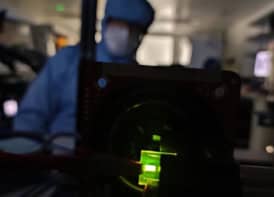
A team of physicists in the US has created an infrared laser beam at a point in mid air, by focusing a UV laser onto a tiny volume of oxygen molecules. Much of the emergent infrared laser light travels back towards the UV laser, sampling the intervening air as it returns. As such, this “backward laser” could potentially provide measurements of pollutants and other molecules in environments that would be hard or impossible to study with conventional laser systems.
There are a number of different ways in which lasers are used to measure the concentration of particular gases in the air, be it pollutants in the atmosphere or the trace gases given off by solid explosives. These techniques include Raman scattering, in which light returns with a shift in wavelength as a result of atomic or molecular laser excitation. However, the scattered light is extremely weak and therefore yields a very low signal. In “stimulated Raman gain”, the signal is enhanced by exciting the gas molecules so that they emit at the same frequency as the laser. This requires the detector to be positioned on the far side of the gas sample, which makes its use in some enclosed or remote environments very difficult.
One way to get round this limitation is to set up a laser in mid-air, its beam sampling the molecules along its path as it returns to the source. In 2004 a group led by See Leang Chin of Laval University in Canada used an infrared laser to ionize nitrogen atoms, the recombining ions and electrons then emitting light coherently. However, this approach calls for a very powerful laser, and Chin’s group obtained only a very small gain coefficient, which means the researchers had to ionize a long stretch of air to get any significant lasing action.
Population inversion
In the latest work, Richard Miles and colleagues at Princeton University used a different mechanism to set up mid-air lasing. By focusing a 226 nm wavelength laser beam onto a tiny volume of air at a distance of between 30 cm and 1 m, they were able to break down oxygen molecules into their constituent atoms and then excite these atoms. Getting these atoms to lase then relied on two crucial properties of the beam’s focus. Being very high intensity, this focus induces a population inversion in the oxygen atoms, ensuring that there are more excited than non-excited atoms.
In addition to this, the shape of the focus – being about a millimetre long and just a hundredth of a millimetre wide – means that any atoms undergoing spontaneous emission tend to stimulate emission in other excited atoms either in the forward or backward directions, rather than at some arbitrary angle to the beam. This leads to high gain in both forward and backward directions.
To confirm that they had indeed generated backward lasing, the researchers placed a CCD detector a metre behind the focus and then placed a more sensitive photomultiplier tube at arbitrary angles to the beam. They found that the brightness behind the focus was some million times higher than that in other directions.
Inspired by hot flames
According to Miles’s colleague, Arthur Dogariu, the inspiration for their backward laser came a few years ago when they were using the same 226 nm laser to study the creation of atomic oxygen inside hot flames. They were using the laser to excite and ionize the atoms liberated by the heat of the flame in order to measure the characteristic emissions of different flames. But what they noticed was that even when they turned the flame off they were still getting a signal – in other words, the laser was breaking up as well as exciting the oxygen.
The researchers now plan to optimize their set-up to see how much higher than can raise the gain of their backward laser. Then they will try and detect various molecules using a number of different detection schemes, including stimulated Raman gain. They say that their backward laser would, for example, make it much easier to scan the atmosphere for signs of methane in the case of a ruptured gas pipe. Alternatively, they say it could be used to enhance the detection of explosives by probing the air around suspect packaging, increasing the distance and reducing the concentrations at which such an analysis could be carried out compared with standard Raman scattering.
Real-world measurements
Chin describes the work as “very interesting” but says he is not yet convinced that such backward lasing could actually be used to detect pollutants and other gases. He maintains that the researchers have not adequately explained how the principle would work with molecules other than oxygen and also cautions that the small-scale laboratory results cannot necessarily be extrapolated to the much larger distances involved in real-world measurements.
Miles Padgett of Glasgow University shares Chin’s sentiment. He says the research is “quite fascinating,” but adds that “for my money the excitement is the effect itself rather than a possible application at this stage”.
The work is described in Science 331 442.



